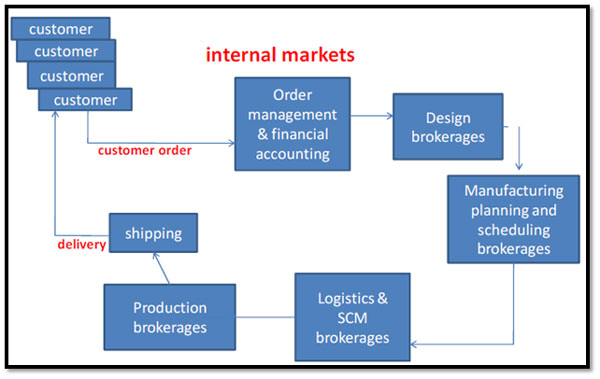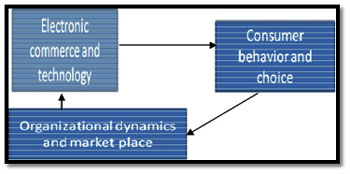Unit-V: Intra-organizational Electronic Commerce
Sakshi Education

Internal commerce is the application of electronic commerce to processes or operations. Specifically, we define internal commerce as using methods and pertinent technologies for supporting internal business processes between individuals, departments, and collaborating organizations.
It is of two types
In a general sense, the term Information System (IS) refers to a system of people, data records and activities that process the data and information in an organization, and it includes the organization's manual and automated processes.
In a narrow sense, the term information system (or computer-based information system) refers to the specific application software that is used to store data records in a computer system and automates some of the information-processing activities of the organization.
These forces are commanding a rethinking of the importance of the networks-computers and communications and their role in the better utilization of corporate information in operational and analytical decision making.
Information architecture (IA) is the art of expressing a model or concept of information used in activities that require explicit details of complex systems.
Among these activities are library systems, content Management Systems, web development, user interactions, data base development, programming, technical writing, enterprise architecture, and critical system software design.
Most definitions have common qualities: a structural design of shared environments, methods of organizing and labeling websites, intranets, and online communities, and ways of bringing the principles of design and architecture to the digital landscape
What Is Cross-functional Management?
Cross-functional management (CFM) manages business processes across the traditional boundaries of the functional areas.
CFM relates to coordinating and sneering the activities of different units for realizing the super ordinate cross-functional goals and policy deployment.
It is concerned with building a better system for achieving for achieving such cross-functional goals as innovation, quality, cost, and delivery.
Macro Forces and Internal Commerce
Macro forces and internal commerce highlights the changes taking place in organization structure and explores how technology and other economic forces are molding arrangements within firms.
The common focus in most of these modern management particles is the use of technology for improving efficiency and eliminating wasteful tasks in business operations. Efficient operations of the macro forces and internal commerce are:
Global Markets: Definition and Characteristics
Definition:
The Oxford University Press defines global marketing as “marketing” on a worldwide scale reconciling or taking commercial advantage of global operational differences, similarities and opportunities in order to meet global objectives.”
Global marketing:
When a company becomes a global marketer, it views the world as one market and creates products that will only require weeks to fit into any regional marketplace. Marketing decisions are made by consulting with marketers in all the countries that will be affected. The goal is to sell the same thing the same way everywhere. The Four elements of global marketing of marketing:
Product:
A global company is one that can create a single product and only have to tweak elements for different markets. For example, coca-cola uses two formulas (one with sugar, one with corn syrup) for all markets.
Price:
Price will always vary from market to market. Price is affected by many variables: cost of product development (produced locally or imported), cost of ingredients, cost of delivery (transportation, tariffs, etc.), and much more.
Placement:
How the product is distributed is also a country-by-country decision influenced by how the competition is being offered to the target market. Using Coca-Cola as an example again, not all cultures use vending machines.
Promotion:
After product research, development and creation, promotion is generally the largest line item in a global company’s marketing budget. At this stage of a company’s development, integrated marketing is the goal.
The global corporation seeks to reduce costs, minimize redundancies in personnel and work, maximize speed of implementation, and to speak with one voice.
Global marketing Advantages and Disadvantages
Advantages:
Disadvantages:
Marketing Research:
It involves the identification, collection, analysis, and dissemination of information. Each phase of this process is important. Finally, the findings, implications and recommendations are provided in a format that allows the information to be used for management decision making and to be acted upon directly. It should be emphasized that marketing research is conducted to assist management in decision making and is not: a means or an end in itself.
Marketing Research Characteristics:
Common success criteria for organizational structures are:
Vertical Organization: Hierarchically structured organization where all management activities are controlled by a centralized management staff.
Vertical organization has two problems:
A vertical market is a group of similar businesses and customers which engage in trade based on specific and specialized needs.
An example of this sort of market is the market for point-of-sale terminals, which are often designed specifically for similar customers and are not available for purchase to the general public.
A vertical market is a market which meets the needs of a particular industry: for example, a piece of equipment used only by semiconductor manufacturers. It is also known as a niche market.
Vertical market software is software aimed at addressing the needs of any given business within a discernible vertical market.
Horizontal organization:
A horizontal market is a market which meets a given need of a wide variety of industries, rather than a specific one.
Examples
In technology, horizontal markets consist of customers that share a common need that exists in many or all industries.
For example, customers that need to purchase computer security services or software exist in such varied industries as finance, healthcare, government, etc.
Horizontal marketing participants often attempt to meet enough of the different needs of vertical markets to gain a presence in the vertical market.
Vertical organization Comparison with horizontal organization:
A vertical market is a market which meets the needs of a particular industry: for example, a piece of equipment used only by semiconductor manufacturers.
A horizontal market is a market which meets a given need of a wide variety of industries, rather than a specific one: for example, word processing software.
New forms of organizational structure:
Two new forms of organizational structures are:
Prominent-virtual organizational structure:
In recent years, virtual enterprises have gained much attention as more and more firms from computer chip manufacturing to aircraft manufacturing. Virtual organization is defined as being closely coupled upstream with its suppliers and downstream with its customers. Virtual organization has been variously referred to as network organizations, organic networks, hybrid networks and value-adding partnership.
Brokerages organizational structure:
The main goal of electronic brokerages organization is to increase the efficiency of the internal marketplace. Internal markets are beginning to appear not only in corporations but even in nonbusiness institutions like the government. They are created inside organizations, allowing firms, suppliers, government agencies to meet the new challenges of the fast-changing environment.
Types of electronic brokerages in internal markets:

Work Flow Automation and Coordination
In last decade, a vision of speeding up or automating routine business tasks has come to be known as “work-flow automation. This vision has its root in the invention of the assembly line and the application of Taylor's scientific management principles. Today, a similar trend is emerging in the automation of knowledge-based business processes called work-flow automation. The goal of work-flow automation is to offer more timely, cost-effective, and integrated ways to make decisions.
Typically, work-flows are decomposed into steps or tasks, which are task oriented. Work-flows can be simple or complex. Simple work-flows typically involve one or two steps or tasks. Another way of looking at work-flow is to determine the amount of cross-functional activity. In other words, companies must adopt an integrated process view of all the business elements.
Work-Flow Coordination
The key element of market-driven business is the coordination of tasks and other resources throughout the company to create value for customer. To this end, effective companies have developed horizontal structures around small multifunctional teams that can move more quickly and easily than businesses that use the traditional function-by-function, sequential approach. Some of the simplest work-flow coordination tools are electronic forms routing applications such as lotus notes. As the number of parties in the work flow increases, good coordination becomes crucial.
Work-flow related technologies
Technology must be the “engine” for driving the initiatives to streamline and transform business interactions. Large organizations are realizing that they have a middle-management offer all the drawn sizing and reorganization of fast few years. Pressures for more comprehensive work-flow systems are building rapidly. Work-flow system are limited to factory like work process.
Middleware is maturing:
By these users or third-party providers need to learn how to develop work-flow applications within middleware environment.
Organizational memory is becoming practical:
The new tools for memory advancing towards, what can be called the “corporate digital library”.
Customization and Internal Commerce
Technology is transforming consumer choices, which in turn transform the dynamics of the marketplace and organizations themselves. Technology embodies adaptability, programmability, flexibility, and other qualities so essential for customization. Customization is explained as:

Mass customization, in marketing, manufacturing, and management, is the use of flexible computer-aided manufacturing systems to produce custom output. "Mass Customization" is the new frontier in business competition for both manufacturing and service industries. Those systems combine the low unit costs of mass production processes with the flexibility of individual customization
Implementation:
Many implementations of mass customization are operational today, such as software-based product configurations which make it possible to add and/or change functionalities of a core product or to build fully custom enclosures from scratch.
Companies which have succeeded with mass-customization business models tend to supply purely electronic products. However, these are not true "mass customizers" in the original sense, since they do not offer an alternative to mass production of material goods.
Four types of mass customization:
Collaborative customization - Firms talk to individual customers to determine the precise product offering that best serves the customer's needs.
Adaptive customization - Firms produce a standardized product, but this product is customizable in the hands of the end-user.
Transparent customization - Firms provide individual customers with unique products, without explicitly telling them that the products are customized.
Cosmetic customization
Firms produce a standardized physical product, but market it to different customers in unique ways. Most of the written materials and thinking about customization has neglected technology. It has been about management and design of work processes.
Today technology is so pervasive that it is virtually impossible to make clear distributions among management, design of work, and technology in almost all forms of business and industry. Technology has moved into products, the workplace, and the market with astonishing speed and thoroughness.
Today, the walls that separated functions in manufacturing and service industries alike are beginning to fall like dominoes. Customization need not be used only in the production of cars, planes, and other traditional products. It can also be used for textiles and clothing. Technology is also enabling new forms of customized production in apparel industry.
What is Supply chain?
Supply chain consists of all parties involved, directly or indirectly in fulfilling a customer request.

Supply Chain Management (SCM)
Supply chain management (SCM) is the management of a network of interconnected business involved in the ultimate provision of product and service packages required by end customers.
Supply Chain Management spans all movement and storage of raw materials, work-in-process inventory, and finished goods from point-of-origin to point-of-consumption.
Supply Chain Management can also refer to supply chain management software which is tools or modules used in executing supply chain transactions, managing supplier relationships and controlling associated business processes.
The Management Components of SCM
The literature on business process re-engineering, buyer-supplier relationships and SCM suggests various possible components that must receive managerial attention when managing supply relationships. Lambert and Cooper (2000) identified the following components which are:
Reverse Supply Chain Reverse logistics is the process of planning, implementing and controlling the efficient, effective inbound flow and storage of secondary goods and related information opposite to the traditional supply chain direction for the purpose of recovering
It is of two types
- Private commerce
- Public commerce
In a general sense, the term Information System (IS) refers to a system of people, data records and activities that process the data and information in an organization, and it includes the organization's manual and automated processes.
In a narrow sense, the term information system (or computer-based information system) refers to the specific application software that is used to store data records in a computer system and automates some of the information-processing activities of the organization.
These forces are commanding a rethinking of the importance of the networks-computers and communications and their role in the better utilization of corporate information in operational and analytical decision making.
Information architecture (IA) is the art of expressing a model or concept of information used in activities that require explicit details of complex systems.
Among these activities are library systems, content Management Systems, web development, user interactions, data base development, programming, technical writing, enterprise architecture, and critical system software design.
Most definitions have common qualities: a structural design of shared environments, methods of organizing and labeling websites, intranets, and online communities, and ways of bringing the principles of design and architecture to the digital landscape
What Is Cross-functional Management?
Cross-functional management (CFM) manages business processes across the traditional boundaries of the functional areas.
CFM relates to coordinating and sneering the activities of different units for realizing the super ordinate cross-functional goals and policy deployment.
It is concerned with building a better system for achieving for achieving such cross-functional goals as innovation, quality, cost, and delivery.
Macro Forces and Internal Commerce
Macro forces and internal commerce highlights the changes taking place in organization structure and explores how technology and other economic forces are molding arrangements within firms.
The common focus in most of these modern management particles is the use of technology for improving efficiency and eliminating wasteful tasks in business operations. Efficient operations of the macro forces and internal commerce are:
- Total quality management
- Business process improvement or business process reengineering.
- The words improvement and reengineering are often used interchangeably, creating confusion.
- Although the goal of these two is same i.e., productivity gains, cost savings, quality and service improvements, cycle-time reduction
- One main reason for reengineering is to better complete in global markets.
Global Markets: Definition and Characteristics
Definition:
The Oxford University Press defines global marketing as “marketing” on a worldwide scale reconciling or taking commercial advantage of global operational differences, similarities and opportunities in order to meet global objectives.”
Global marketing:
When a company becomes a global marketer, it views the world as one market and creates products that will only require weeks to fit into any regional marketplace. Marketing decisions are made by consulting with marketers in all the countries that will be affected. The goal is to sell the same thing the same way everywhere. The Four elements of global marketing of marketing:
Product:
A global company is one that can create a single product and only have to tweak elements for different markets. For example, coca-cola uses two formulas (one with sugar, one with corn syrup) for all markets.
Price:
Price will always vary from market to market. Price is affected by many variables: cost of product development (produced locally or imported), cost of ingredients, cost of delivery (transportation, tariffs, etc.), and much more.
Placement:
How the product is distributed is also a country-by-country decision influenced by how the competition is being offered to the target market. Using Coca-Cola as an example again, not all cultures use vending machines.
Promotion:
After product research, development and creation, promotion is generally the largest line item in a global company’s marketing budget. At this stage of a company’s development, integrated marketing is the goal.
The global corporation seeks to reduce costs, minimize redundancies in personnel and work, maximize speed of implementation, and to speak with one voice.
Global marketing Advantages and Disadvantages
Advantages:
- Economies of scale in production and distribution Power and scope
- Consistency in brand image
- Ability to leverage good ideas quickly and efficiently
- Uniformity of marketing practices
- Helps to establish relationships outside of the "political arena“
Disadvantages:
- Differences in consumer needs, wants, and usage patterns for products
- Differences in consumer response to marketing mix elements.
- Differences in brand and product development and the competitive environment.
- Differences in administrative procedures and Differences in product placement.
Marketing Research:
It involves the identification, collection, analysis, and dissemination of information. Each phase of this process is important. Finally, the findings, implications and recommendations are provided in a format that allows the information to be used for management decision making and to be acted upon directly. It should be emphasized that marketing research is conducted to assist management in decision making and is not: a means or an end in itself.
Marketing Research Characteristics:
- First, marketing research is systematic. Thus, systematic planning is required at all the stages of the marketing research process.
- The procedures followed at each stage are methodologically sound, well documented, and, as much as possible, planned in advance.
- Marketing research uses the scientific method in that data are collected and analyzed to test prior notions or hypotheses.
- Marketing research is objective. It attempts to provide accurate information that reflects a true state of affairs. It should be conducted impartially.
- An organizational structure is a mostly hierarchical concept of subordination of entities that collaborate and contribute to serve one common aim.
- Organizations are a number of clustered entities. The structure of an organization is usually set up in one of a variety of styles, dependent on their objectives and ambience.
- Organizational structure allows the expressed allocation of responsibilities for different functions and processes to different entities.
Common success criteria for organizational structures are:
- Decentralized reporting
- Flat hierarchy
- High transient speed
- High transparency
Vertical Organization: Hierarchically structured organization where all management activities are controlled by a centralized management staff.
Vertical organization has two problems:
- First, it creates boundaries that discourage employees in different departments from interacting with one another.
- Second, departmental goals are typically set in a way that could cause friction among departments.
A vertical market is a group of similar businesses and customers which engage in trade based on specific and specialized needs.
An example of this sort of market is the market for point-of-sale terminals, which are often designed specifically for similar customers and are not available for purchase to the general public.
A vertical market is a market which meets the needs of a particular industry: for example, a piece of equipment used only by semiconductor manufacturers. It is also known as a niche market.
Vertical market software is software aimed at addressing the needs of any given business within a discernible vertical market.
Horizontal organization:
A horizontal market is a market which meets a given need of a wide variety of industries, rather than a specific one.
Examples
In technology, horizontal markets consist of customers that share a common need that exists in many or all industries.
For example, customers that need to purchase computer security services or software exist in such varied industries as finance, healthcare, government, etc.
Horizontal marketing participants often attempt to meet enough of the different needs of vertical markets to gain a presence in the vertical market.
Vertical organization Comparison with horizontal organization:
A vertical market is a market which meets the needs of a particular industry: for example, a piece of equipment used only by semiconductor manufacturers.
A horizontal market is a market which meets a given need of a wide variety of industries, rather than a specific one: for example, word processing software.
New forms of organizational structure:
Two new forms of organizational structures are:
Prominent-virtual organizational structure:
In recent years, virtual enterprises have gained much attention as more and more firms from computer chip manufacturing to aircraft manufacturing. Virtual organization is defined as being closely coupled upstream with its suppliers and downstream with its customers. Virtual organization has been variously referred to as network organizations, organic networks, hybrid networks and value-adding partnership.
Brokerages organizational structure:
The main goal of electronic brokerages organization is to increase the efficiency of the internal marketplace. Internal markets are beginning to appear not only in corporations but even in nonbusiness institutions like the government. They are created inside organizations, allowing firms, suppliers, government agencies to meet the new challenges of the fast-changing environment.
Types of electronic brokerages in internal markets:

Work Flow Automation and Coordination
In last decade, a vision of speeding up or automating routine business tasks has come to be known as “work-flow automation. This vision has its root in the invention of the assembly line and the application of Taylor's scientific management principles. Today, a similar trend is emerging in the automation of knowledge-based business processes called work-flow automation. The goal of work-flow automation is to offer more timely, cost-effective, and integrated ways to make decisions.
Typically, work-flows are decomposed into steps or tasks, which are task oriented. Work-flows can be simple or complex. Simple work-flows typically involve one or two steps or tasks. Another way of looking at work-flow is to determine the amount of cross-functional activity. In other words, companies must adopt an integrated process view of all the business elements.
Work-Flow Coordination
The key element of market-driven business is the coordination of tasks and other resources throughout the company to create value for customer. To this end, effective companies have developed horizontal structures around small multifunctional teams that can move more quickly and easily than businesses that use the traditional function-by-function, sequential approach. Some of the simplest work-flow coordination tools are electronic forms routing applications such as lotus notes. As the number of parties in the work flow increases, good coordination becomes crucial.
Work-flow related technologies
Technology must be the “engine” for driving the initiatives to streamline and transform business interactions. Large organizations are realizing that they have a middle-management offer all the drawn sizing and reorganization of fast few years. Pressures for more comprehensive work-flow systems are building rapidly. Work-flow system are limited to factory like work process.
Middleware is maturing:
By these users or third-party providers need to learn how to develop work-flow applications within middleware environment.
Organizational memory is becoming practical:
The new tools for memory advancing towards, what can be called the “corporate digital library”.
Customization and Internal Commerce
Technology is transforming consumer choices, which in turn transform the dynamics of the marketplace and organizations themselves. Technology embodies adaptability, programmability, flexibility, and other qualities so essential for customization. Customization is explained as:

Mass customization, in marketing, manufacturing, and management, is the use of flexible computer-aided manufacturing systems to produce custom output. "Mass Customization" is the new frontier in business competition for both manufacturing and service industries. Those systems combine the low unit costs of mass production processes with the flexibility of individual customization
Implementation:
Many implementations of mass customization are operational today, such as software-based product configurations which make it possible to add and/or change functionalities of a core product or to build fully custom enclosures from scratch.
Companies which have succeeded with mass-customization business models tend to supply purely electronic products. However, these are not true "mass customizers" in the original sense, since they do not offer an alternative to mass production of material goods.
Four types of mass customization:
Collaborative customization - Firms talk to individual customers to determine the precise product offering that best serves the customer's needs.
Adaptive customization - Firms produce a standardized product, but this product is customizable in the hands of the end-user.
Transparent customization - Firms provide individual customers with unique products, without explicitly telling them that the products are customized.
Cosmetic customization
Firms produce a standardized physical product, but market it to different customers in unique ways. Most of the written materials and thinking about customization has neglected technology. It has been about management and design of work processes.
Today technology is so pervasive that it is virtually impossible to make clear distributions among management, design of work, and technology in almost all forms of business and industry. Technology has moved into products, the workplace, and the market with astonishing speed and thoroughness.
Today, the walls that separated functions in manufacturing and service industries alike are beginning to fall like dominoes. Customization need not be used only in the production of cars, planes, and other traditional products. It can also be used for textiles and clothing. Technology is also enabling new forms of customized production in apparel industry.
What is Supply chain?
Supply chain consists of all parties involved, directly or indirectly in fulfilling a customer request.

Supply Chain Management (SCM)
Supply chain management (SCM) is the management of a network of interconnected business involved in the ultimate provision of product and service packages required by end customers.
Supply Chain Management spans all movement and storage of raw materials, work-in-process inventory, and finished goods from point-of-origin to point-of-consumption.
Supply Chain Management can also refer to supply chain management software which is tools or modules used in executing supply chain transactions, managing supplier relationships and controlling associated business processes.
The Management Components of SCM
The literature on business process re-engineering, buyer-supplier relationships and SCM suggests various possible components that must receive managerial attention when managing supply relationships. Lambert and Cooper (2000) identified the following components which are:
- Planning and control -Work structure -Organization structure
- Product flow facility structure -Information flow facility structure - Management methods
- Power and leadership structure -Risk and reward structure -Culture and attitude
Reverse Supply Chain Reverse logistics is the process of planning, implementing and controlling the efficient, effective inbound flow and storage of secondary goods and related information opposite to the traditional supply chain direction for the purpose of recovering
Published date : 28 Jul 2015 12:04PM






